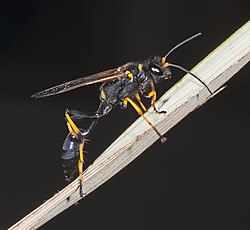Mud dauber
| Mud dauber | |
|---|---|
 |
|
| Black and yellow mud dauber Sceliphron caementarium |
|
| Scientific classification | |
| Kingdom: | Animalia |
| Phylum: | Arthropoda |
| Class: | Insecta |
| Order: | Hymenoptera |
| Suborder: | Apocrita |
| Superfamily: | Apoidea |
| Families | |
|
Some Sphecidae and Crabronidae |
|
Some Sphecidae and Crabronidae
Mud dauber (or "mud wasp") is a name commonly applied to a number of wasps from either the family Sphecidae or Crabronidae that build their nests from mud. Mud daubers belong to different families and are variable in appearance. Most resemble long, slender wasps about 1-inch (25 mm) in length. The name refers to the nests that are made by the female wasps, which consist of mud molded into place by the wasp's mandibles. Mud daubers are not normally aggressive, but can become belligerent when threatened. Stings are uncommon.
The organ pipe mud dauber, one of many mud daubers in the family Crabronidae, builds nests in the shape of a cylindrical tube resembling an organ pipe or pan flute. Common sites include vertical or horizontal faces of walls, cliffs, bridges, overhangs and shelter caves or other structures.
The nest of the black and yellow mud dauber is a simple, one-cell, urn-shaped nest that is attached to crevices, cracks and corners. Each nest contains one egg. Usually several nests are clumped together and covered in mud.
The metallic-blue mud dauber, another sphecid, builds typically horizontal oval nests, but occasionally refurbishes the abandoned nests of other species and preys primarily on black widow spiders. Blue mud daubers sometimes appropriate old nests of black-and-yellow mud daubers. They carry water to them and recondition them for their own purposes. The two species commonly occupy the same barns, porches, or other nest sites.
All three species may occupy the same sites year after year, creating large numbers of nests. Mud dauber nests can last many years in protected locations and are often used as nest sites by other kinds of wasps and bees, as well as other types of insects.
One disadvantage to making nests is that most, if not all, of the nest-maker’s offspring are concentrated in one place, making them highly vulnerable to predation. Once a predator finds a nest, it can plunder it cell by cell. A variety of parasitic wasps, ranging from extremely tiny chalcidoid wasps to larger, bright green chrysidid wasps attack mud dauber nests. They pirate provisions and offspring as food for their own offspring.
...
Wikipedia
